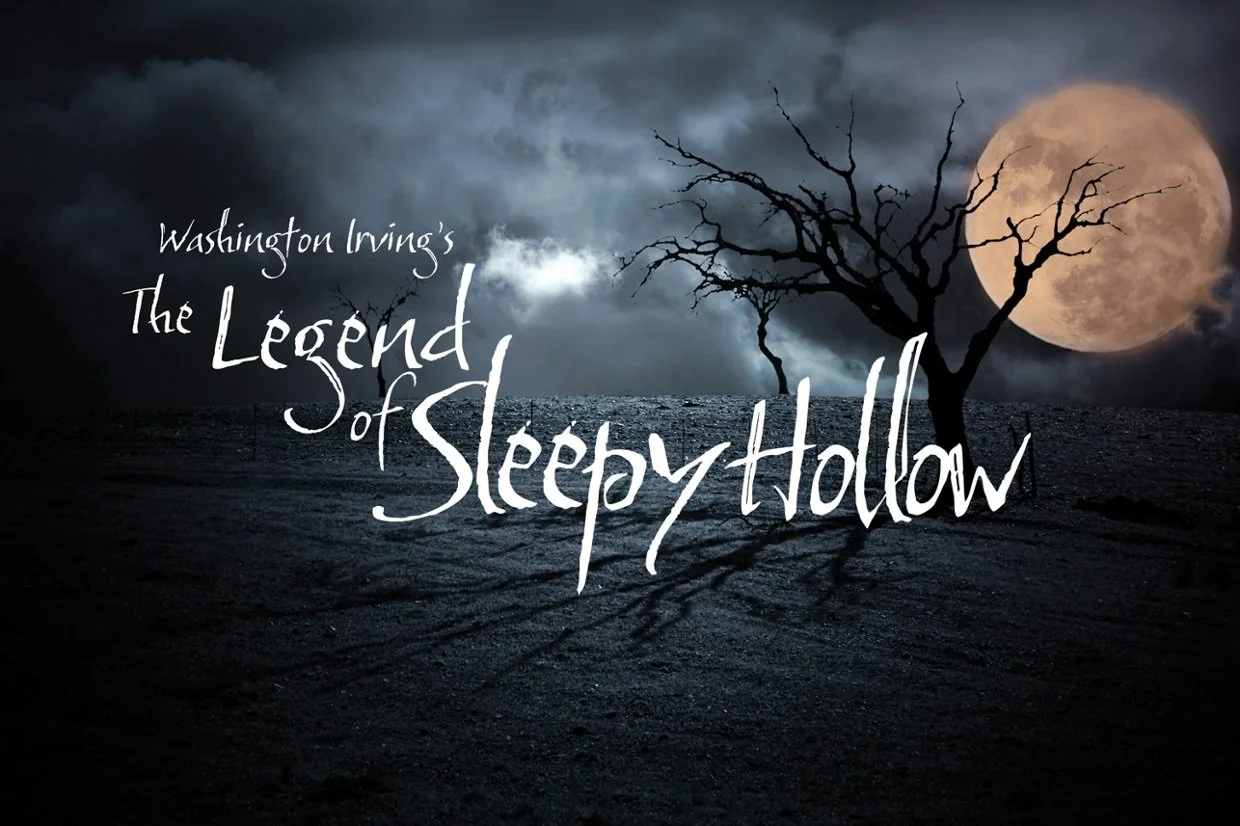The Legend of Sleepy Hollow by Washington Irving
FULL AUDIOBOOK
FULL AUDIOBOOK
(CHAPTER BY CHAPTER PLAYLIST)
American author Washington Irving published “The Legend of Sleepy Hollow” in 1820 as part of his short story collection The Sketchbook of Geoffrey Crayon, Gent while living abroad in England. “The Legend of Sleepy Hollow” is a ghost story, an example of American gothic fiction that evokes horror, folklore, and the supernatural. “The Legend of Sleepy Hollow” has become a classic Halloween tale for its spectral villain, the Headless Horseman, and its hapless hero, Ichabod Crane. This guide uses the Kindle E-Bookarama edition for page citations.
Dietrich Knickerbocker, a fictional Dutch historian of Irving’s invention, narrates the story, which is set near the northern New York port village of Tarry Town (real name Tarrytown, where Irving settled in 1835), situated on the Tappan Zee River (also the name of the real river that runs through the region). Two miles north of Tarry Town is a valley called Sleepy Hollow, which is where the main action of the story takes place. The narrator notes that Sleepy Hollow has a somnolent, mysterious quality. The Dutch residents, who have lived there for generations, believe the area is bewitched, either by “a High German doctor, during the early days of settlements; […] [or] an old Indian chief, the prophet or wizard of his tribe” (3). Regardless of the source, superstitions, visions, and hallucinations abound, making the area infamous and avoided by outsiders.
The most feared spirit in the region is a ghostly rider on horseback without a head. He is rumored to be a Hessian—a German soldier who fought with the British—general beheaded by a cannonball during the American Revolutionary War (3). Residents and local historians believe that the Headless Horseman gallops through the valley at night searching for his head and terrorizing those who get in his way. He returns to the church graveyard, where his body is buried, each morning. The narrator claims that he visited Sleepy Hollow when he was young, so he knows the region firsthand.
After setting the scene, the narrator tells the story of Ichabod Crane, an itinerant schoolteacher who moved from Connecticut to Sleepy Hollow 30 years before, around 1790. Ichabod is tall and lanky, with a high-beaked nose and large green eyes. He is a rather comic figure, with spindly arms dangling from too-short sleeves, feet like shovels, large ears, and a tiny flat head (9). These details are significant to the plot because the narrator will refer to Ichabod’s awkward movements and physiognomy throughout the story. Ichabod is the town’s only teacher, and he teachers the male children of local farmers in a one-room schoolhouse.
Ichabod becomes popular in town by making himself useful. He helps the farmers with whom he lodges and makes friends with the town’s women by providing lessons in psalmistry (the singing of psalms) and exchanging regional gossip (16). He enjoys home-cooked meals and ingratiates himself to his students’ mothers for invitations to dinners. Ichabod is an aficionado on witchcraft. He devours stories from Cotton Mather’s History of New England Witchcraft and eagerly trades stories of witches, omens, and strange events in Connecticut with the locals.
Not long after moving to Sleepy Hollow, Ichabod falls in love with one of his psalmistry students, Katrina Van Tassel, the 18-year-old daughter of Baltus Van Tassel, the town’s wealthiest farmer. Katrina is the most sought-after young lady in the village because of her beauty and her father’s wealth. She has many “rustic admirers,” chief among them the burly, jovial, and renowned equestrian Abraham Van Brunt, known locally as Brom Bones (32). Brom finds Ichabod's attentions to Katrina annoying, but because Ichabod avoids confrontation, Brom cannot settle the matter with a fight, as he would prefer. Instead, he and his friends pull pranks on Ichabod, damage his schoolhouse, and taunt him from afar. These acts do not deter Ichabod, who continues to visit Katrina and spend time with her during their singing lessons.
One autumn day, a “negro” arrives at the schoolhouse to deliver an invitation for Ichabod to attend a party at Van Tassel’s home that evening (40). Ichabod is excited, believing it will be the perfect opportunity to propose to Katrina. To arrive in style, he borrows a horse from the farmer with whom he is boarding. However, the horse turns out to be an old, ill-tempered plow-horse whose physical state and temperament will become important later in the story.
The party is sumptuous, with music, dancing, and mountains of food, at which Ichabod marvels. He dances with Katrina, who seems to enjoy his attentions, and this angers Brom Bones, who sulks in the corner (54).
After the dancing, the older men gather to tell stories about the Revolutionary War. The war took place from 1775 to 1783, so it is recent history at the time of the story. Even though many of the stories are tall tales, some of the men did in fact participate in the war. Soon, the conversation turns to stories about the Headless Horseman. Brom adds his own story in which he and his horse Daredevil race the Horseman for a bowl of punch. Afraid of losing, the Headless Horseman vanishes in a ball of fire. The stories make an impression on Ichabod, who has had strange experiences passing through the forest in Sleepy Hollow, which is where Brom met the Horseman.
As the party ends, Ichabod confesses his love to Katrina, but after a short meeting, he leaves deflated. The meeting occurs in a private location, and the narrator professes not to know what transpired between them. He speculates that Katrina may have been leading Ichabod on to attract another suitor’s attention.
On the long ride home through Sleepy Hollow, Ichabod recalls the night’s ghost stories and becomes anxious. He passes a large tree and a swamp, each of which is the site of a gruesome event. He senses a rider behind him and tries to pick up his pace, but his horse veers off course, going deeper into the forest. Ichabod calls out to ask who is galloping behind him but receives no response. He turns to see the Headless Horseman astride a black horse, holding a head in his lap. After a wild, terrifying chase through the forest, Ichabod sees the church in a clearing beyond the bridge and believes he will be safe. As Ichabod crosses the bridge, he looks back to see if the Horseman has disappeared, as Brom Bones and the others claimed. Instead, the Horseman continues to follow Ichabod and hurls his head, striking Ichabod and knocking him off his horse.
In the morning, the old horse returns to his owner, but Ichabod has disappeared. The townspeople find the remnants of the previous night’s attack, including a saddle, hoofprints in the mud, and Ichabod’s hat resting near the broken pieces of a pumpkin. After searching the area, they give up, unable to find Ichabod’s body.
Ichabod had few possessions and no personal attachments; therefore, the townspeople do not take any further action regarding his disappearance. Most conclude that the Headless Horseman carried him away (80). The narrator provides a competing story he heard years later, from a farmer who claimed that Ichabod fled, made his way to New York, and became a politician. Brom Bones marries Katrina and looks “exceedingly knowing” when anyone mentions the story of Ichabod Crane (82). The narrator concludes with the townspeople’s belief that Ichabod became a ghost who haunts the now disused schoolhouse and that some hear his mournful singing as they pass through the hills.

